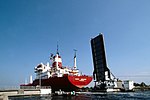Château de Bénouville

The Château de Bénouville (French pronunciation: [ʃato də benuvil]) is a building in Bénouville, Normandy, near Caen (northern France). It was designed in 1769 by architect Claude Nicolas Ledoux and built in 1770-74 and 1776-80 at the request of Hyppolite-François Sanguin, marquis of Livry (1715–1789) and his marquise Thérèse Bonne Gillain de Bénouville, heiress of the property. The interior was under construction from 1778 to 1780 under the direction of Jean-François-Étienne Gilet, the architect of Caen. In 1792, it was purchased from the widowed marquise by a fermier général (tax collector) who was guillotined in 1794. His daughter inherited the property which remained in that family until 1927. It then became the property of the general council of Calvados which turned it into a maternity hospital (singer Gérard Lenorman was born there). In 1980, it was rehabilitated and restored, opening its doors to the public in 1990. This château is one of the best preserved works of Ledoux, making it a major monument of neoclassical architecture at the end of the eighteenth century. Its monumental staircase and its exterior architecture were very modern for the time.
Excerpt from the Wikipedia article Château de Bénouville (License: CC BY-SA 3.0, Authors, Images).Château de Bénouville
Voie Verte Caen-Ouistreham, Caen
Geographical coordinates (GPS) Address External links Nearby Places Show on map
Geographical coordinates (GPS)
| Latitude | Longitude |
|---|---|
| N 49.236111111111 ° | E -0.28111111111111 ° |
Address
Château de Bénouville
Voie Verte Caen-Ouistreham
14970 Caen
Normandy, France
Open on Google Maps











